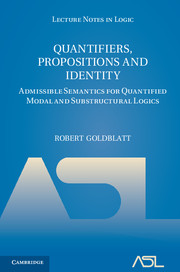 Quantifiers, Propositions and Identity
Quantifiers, Propositions and Identity Published online by Cambridge University Press: 07 September 2011
We now extend our language for quantified modal logic by adding a predicate symbol ≈ for an identity relation, allowing us to express assertions about the identity of individuals. A two-sorted language is developed, with one sort of term standing for individual concepts, represented as partial functions from worlds to individuals, and the other sort specialising to concepts that are rigid, i.e. have the same value in accessible worlds. The identity predicate allows the existence predicate ε to be defined, taking ετ to be the self-identity formula τ ≈ τ, whose corresponding proposition/truth set is the domain of the partial function interpreting τ. The use of admissibility is extended from propositions to individuals by requiring each model to have a designated set of admissible individual concepts, within which there is a designated set of admissible rigid ones.
We axiomatise the set of formulas that are valid in these models, using a new inference rule that allows deduction of assertions of non-existence (¬ετ). The logic characterised by Kripkean models is then treated separately. The final section of the chapter gives a semantic analysis of Russelian definite description terms ιx.ϕ in this context, and shows how to construct canonical models and axiomatisations for logics in languages that have these description terms as well as the identity predicate.
To save this book to your Kindle, first ensure [email protected] is added to your Approved Personal Document E-mail List under your Personal Document Settings on the Manage Your Content and Devices page of your Amazon account. Then enter the ‘name’ part of your Kindle email address below. Find out more about saving to your Kindle.
Note you can select to save to either the @free.kindle.com or @kindle.com variations. ‘@free.kindle.com’ emails are free but can only be saved to your device when it is connected to wi-fi. ‘@kindle.com’ emails can be delivered even when you are not connected to wi-fi, but note that service fees apply.
Find out more about the Kindle Personal Document Service.
To save content items to your account, please confirm that you agree to abide by our usage policies. If this is the first time you use this feature, you will be asked to authorise Cambridge Core to connect with your account. Find out more about saving content to Dropbox.
To save content items to your account, please confirm that you agree to abide by our usage policies. If this is the first time you use this feature, you will be asked to authorise Cambridge Core to connect with your account. Find out more about saving content to Google Drive.